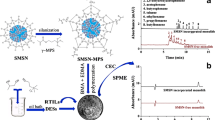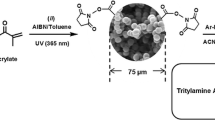Abstract
Monolithic stationary phases for use in capillary electrochromatography were prepared by incorporation of mesoporous silica particles (of type MCM-41 or UVM-7) in a polymer obtained from butyl methacrylate and ethylene glycol dimethacrylate as monomers, 1,4-butanediol and 1-propanol as porogen, and azobisisobutyronitrile as initiator. The stability of the dispersions with varying fractions of silica particles was investigated by UV-vis spectrometry. Using continuous stirring during the capillary filling and short UV-polymerization times, polymeric beds with homogenously dispersed mesoporous particles (with contents up to 35 wt% of silica) are obtained. The resulting hybrid monolithic columns were characterized using scanning electron microscopy. The chromatographic performance of these novel stationary phases was evaluated by using alkyl benzenes and benzoic acid derivatives as test analytes. The use of these polymers leads to increased retention and separation efficiency compared to the parent monolith. The column efficiency reached values of up to 140,000 plates m−1. The resulting hybrid monolithic columns also exhibited a satisfactory reproducibility with relative standard deviations of ca. 14% (batch-to-batch).

Hybrid polymer monoliths containing large amounts of mesoporous silica-particles (MCM-41 or UVM-7) were prepared by UV initiation. The prepared monolithic columns showed higher retention times and efficiencies than parent monoliths for alkyl benzenes and benzoic acid derivatives.



Similar content being viewed by others
References
Kresge KT, Leonowicz ME, Roth WJ, Vartuli JC, Beck JS (1992) Ordered mesoporous molecular sieves synthesized by a liquid-crystal template mechanism. Nature 359:710–712
Luque R, Balu AM, Campelo JM, Gracia MD, Losada E, Pineda A, Romero AA, Serrano-Ruiz JC (2012) Catalytic applications of mesoporous silica-based materials. Catalysis 24:253–280
Li Z, Barnes JC, Bosoy A, Stoddart JF, Zink JI (2012) Mesoporous silica nanoparticles in biomedical applications. Chem Soc Rev 41:2590–2605
Walcarius A, Collinson MM (2009) Analytical chemistry with silica sol-gels: Traditional routes to new materials for chemical analysis. Annu Rev Anal Chem 2:121–143
Trewyn BG, Slowing II, Giri S, Chen HT, Lin VSY (2007) Synthesis and functionalization of a mesoporous silica nanoparticle based on the sol-gel process and applications in controlled release. Acc Chem Res 40(9):846–853
Zhao D, Sun J, Li Q, Stucky GD (2000) Morphological control of highly ordered mesoporous silica SBA-15. Chem Mater 12:275–279
Rahmat N, Abdullah AZ, Mohamed AR (2010) A review: Mesoporous santa barbara amorphous-15, types, synthesis and its applications towards biorefinery production. Am J Appl Sci 7:1579–1586
Gustafsson H, Thörn C, Holmberg K (2011) A comparison of lipase and trypsin encapsulated in mesoporous materials with varying pore sizes and pH conditions. Colloids Surf. B Biointerfaces 15:464–471
Cabrera S, El Haskouri J, Guillem C, Latorre J, Beltrán A, Beltrán D, Marcos MD, Amoros P (2000) Generalised syntheses of ordered mesoporous oxides: the atrane route. Solid State Sci 2(4):405–420
El Haskouri J, Ortiz de Zárate D, Guillem C, Latorre J, Caldés M, Beltrán A, Beltrán D, Descalzo AB, Rodríguez G, Martínez-Mañez R, Marcos MD, Amorós P (2002) Silica-based powders and monoliths with bimodal pore systems. Chem Commun 4:330–331
El Haskouri J, Morales JM, Ortiz de Zárate D, Fernandez L, Latorre J, Guillem C, Beltrán A, Beltrán D, Amorós P (2008) Nanoparticulated silicas with bimodal porosity: chemical control of the pore sizes. Inorg Chem 47(18):8267–8277
Pérez-Cabero M, Hungría AB, Morales JM, Tortajada M, Ramón D, Moragues A, El Haskouri J, Beltrán A, Beltrán D, Amorós P (2012) Interconnected mesopores and high accessibility in UVM-7-like silicas. J Nanopart Res 14:1045–1048
Ros-Lis JV, Casasús R, Comes M, Coll C, Marcos MD, Martínez-Máñez R, Sancenón F, Soto J, Amorós P, El Haskouri J, Garró N, Rurack K (2008) A mesoporous 3D hybrid material with dual functionality for Hg2+ detection and adsorption. Chemistry 14(27):8267–8278
Svec F (2012) Quest for organic polymer-based monolithic columns affording enhanced efficiency in high performance liquid chromatography separations of small molecules in isocratic mode. J Chromatogr A 1228:250–262
Svec F, Lv Y (2015) Advances and recent trends in the field of monolithic columns for chromatography. Anal Chem 87:250–273
Chen X, Tolley HD, Lee ML (2011) Monolithic capillary columns synthesized from a single phosphate-containing dimethacrylate monomer for cation-exchange chromatography of peptides and proteins. J Chromatogr A 1218:4322–4331
Tasfiyati AN, Iftitah ED, Sakti SP, Sabarudin A (2016) Evaluation of glycidyl methacrylate-based monolith functionalized with weak anion exchange moiety inside 0.5 mm i.d. column for liquid chromatographic separation of DNA. Anal Chem Res 7:9–16
Lämmerhofer M, Gargano A (2010) Monoliths with chiral surface functionalization for enantioselective capillary electrochromatography. J Pharmaceut Biomed Anal 53:1091–1123
Acquah C, Obeng EM, Agyei D, Ongkudon CM, Moy CKS, Danquah MK (2017) Nano-doped monolithic materials for molecular separation. Separations 4:2–22
Navarro-Pascual-Ahuir M, Lucena R, Cárdenas S, Ramis-Ramos G, Valcárcel M, Herrero-Martínez JM (2014) UV-polymerized butyl methacrylate monoliths with embedded carboxylic single-walled carbon nanotubes for CEC applications. Anal Bioanal Chem 406:6329–6336
Zhang LS, Gao SP, Huang YP, Liu ZS (2016) Green synthesis of polymer monoliths incorporated with carbon nanotubes in room temperature ionic liquid and deep eutectic solvents. Talanta 154:335–340
Navarro-Pascual-Ahuir M, Lerma-García MJ, Ramis-Ramos G, Simó-Alfonso EF, Herrero-Martínez JM (2013) Preparation and evaluation of lauryl methacrylate monoliths with embedded silver nanoparticles for capillary electrochromatography. Electrophoresis 34:925–934
Lei W, Zhang LY, Wan L, Shi BF, Wang YQ, Zhang WB (2012) Hybrid monolithic columns with nanoparticles incorporated for capillary electrochromatography. J Chromatogr A 1239:67–71
Wan L, Zhang L, Lei W, Zhu Y, Zhang W, Wang Y (2012) Novel hybrid organic-inorganic monolithic column containing mesoporous nanoparticles for capillary electrochromatography. Talanta 98:277–281
Liu Y, Chen Y, Yang H, Nie L, Yao S (2013) Cage-like silica nanoparticles-functionalized silica hybrid monolith for high performance capillary electrochromatography via "one-pot" process. J Chromatogr A 1283:132–139
Serjeant EP, Dempsey B (1979) Ionization constants of organic acids in aqueous solution, Pergamon
Peters EC, Petro M, Svec F, Fréchet JMJ (1998) Molded Rigid Polymer Monoliths as Separation Media for Capillary Electrochromatography. 1. Fine Control of Porous Properties and Surface Chemistry. Anal Chem 70:2288–2295
Huang HY, Lin CL, Wu CY, Cheng YJ, Lin CH (2013) Metal organic framework-organic polymer monolith stationary phases for capillary electrochromatography and nano-liquid chromatography. Anal Chim Acta 779:96–103
Carrasco-Correa EJ, Ramis-Ramos G, Herrero-Martínez JM (2015) Hybrid methacrylate monolithic columns containing magnetic nanoparticles for capillary electrochromatography. J Chromatogr A 1385:77–84
Jiang Z, Reilly J, Brian E, Smith NW (2009) Novel zwitterionic polyphosphorylcholine monolithic column for hydrophilic interaction chromatography. J Chromatogr A 1216:2439–2448
Zhang L, Zhao Q, Li X, Li X, Huang Y, Liu Z (2016) Green synthesis of mesoporous molecular sieve incorporated monoliths using room temperature ionic liquid and deep eutectic solvents. Talanta 161:660–667
Zhang L, Wang Z, Zhang W (2013) Sub-micrometer mesoporous SBA-15 silica rods as stationary phase for capillary electrochromatography separation. Chin. J. Chromatogr 31(4):335–341
Liu S, Peng J, Liu Z, Liu Z, Zhang H, Wu R (2016) One-pot approach to prepare organo-silica hybrid capillary monolithic column with intact mesoporous silica particles as building block. Sci Rep 6:34718
Wu C, Liang Y, Yang K, Min Y, Liang Z, Zhang L, Zhang Y (2016) Clickable periodic mesoporous organosilica monolith for highly efficient capillary chromatographic separation. Anal Chem 88:1521–1525
Acknowledgements
This work was supported by projects CTQ2014-52765-R and MAT2015-64139-C4-2-R (MINECO of Spain and Fondo Europeo de Desarrollo Regional, FEDER) and PROMETEO/2016/145 (Conselleria d’Educació, Investigació, Cultura i Esport, Generalitat Valenciana, Spain).
Author information
Authors and Affiliations
Corresponding author
Ethics declarations
The author(s) declare that they have no competing interests.
Electronic supplementary material
ESM 1
(DOCX 2009 kb)
Rights and permissions
About this article
Cite this article
Weller, A., Carrasco-Correa, E.J., Belenguer-Sapiña, C. et al. Organo-silica hybrid capillary monolithic column with mesoporous silica particles for separation of small aromatic molecules. Microchim Acta 184, 3799–3808 (2017). https://doi.org/10.1007/s00604-017-2404-z
Received:
Accepted:
Published:
Issue Date:
DOI: https://doi.org/10.1007/s00604-017-2404-z




